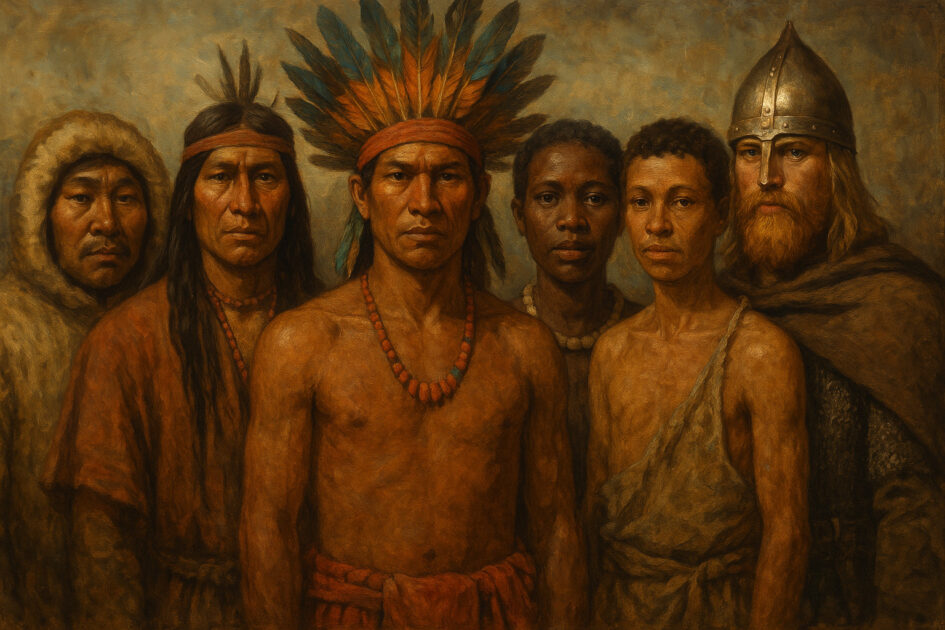The Weaponization of “Indigenous” Status: A Case Study in Anti-White Ideological Manipulation
The term “indigenous” once referred to the people most deeply rooted in a land—those with the oldest ancestral, genetic, and cultural ties to a region. Today, it has been ideologically corrupted. It is no longer used to neutrally describe historical continuity, but instead functions as a selective political tool to elevate non-White groups and deny native status to Whites, even in their own ancestral homelands.
This double standard becomes obvious when one examines the contradictions and historical inversions applied across different populations. Whether in Europe, the Americas, or Africa, the designation of “indigenous” no longer follows consistent rules—it follows one rule: Whites must always be cast as the outsiders, even when they clearly are not.
1. The Sami vs. Native White Europeans
The Sami are widely described as the “indigenous” people of northern Scandinavia. Yet they are not the original inhabitants of Europe. Genetic and linguistic evidence shows that the Sami migrated from Northeast Eurasia (Siberia) into Fennoscandia approximately 2,500–4,000 years ago. Their languages belong to the Uralic family, not Indo-European, and their genetic profile contains Siberian ancestry distinct from that of other Europeans.
Meanwhile, White Europeans—descendants of Mesolithic hunter-gatherers, Neolithic farmers, and Bronze Age Indo-Europeans—have been present on the European continent for tens of thousands of years. Their ancestral roots run back to the Upper Paleolithic, with continuous cultural and genetic development in Europe’s soil.
Despite this, the later-arriving, more genetically divergent Sami are elevated as “indigenous,” while the much older and more established European populations are framed as colonizers, settlers, or invaders in their own lands. This is not an honest application of the term—it is an inversion of history for ideological purposes.
2. The Inuit and the Myth of a Unified “Indigenous America”
The public narrative surrounding “indigenous peoples” in the Americas deliberately erases vast differences between populations and imposes a simplistic binary of “native” versus “colonizer.” This is particularly obvious in the treatment of the Inuit and the public’s total unawareness of their relatively recent migration and distinct ancestry.
The Inuit, Yupik, and Aleut peoples—sometimes collectively labeled “Eskimos”—are not descended from the early Native American populations that entered the Americas ~15,000–20,000 years ago. Instead, they are the descendants of the Thule culture, a group of Neo-Eskimos who migrated from Siberia into the Arctic between 700 and 1000 AD. They represent an entirely separate wave of migration from East Asia, with limited to no direct genetic relation to the earlier Amerindian founders.
Even more critically, the Inuit displaced an earlier population known as the Paleo-Eskimos, including the Saqqaq and Dorset peoples. These Paleo-Eskimos were genetically and culturally distinct from both the Inuit and the main Native American population, and they inhabited Arctic regions for thousands of years before being pushed out—or entirely extinguished—by the Thule expansion.
The names “Paleo-Eskimo” and “Neo-Eskimo” have allowed activists and the media to equivocate, falsely presenting the Inuit as the timeless original inhabitants of the Arctic, when in fact they are newcomers who arrived after the Norse.
Indeed, the Norse established permanent settlements in Greenland around 985 AD and explored parts of mainland North America (likely Newfoundland) by ~1000 AD, centuries before the Inuit reached those same regions. Norse colonies in Greenland persisted until around 1450 AD—a span of nearly 500 years. During this time, the Inuit were expanding into Greenland, in some cases coming into conflict with Norse settlers.
Despite this, modern ideology insists on labeling the Inuit “indigenous,” while casting the Norse (and by extension modern Europeans) as colonial outsiders—even in cases where the Inuit arrived later. This reveals that “indigenous” is not about historical priority or continuity. It is about which narrative serves to delegitimize Europeans.
Even beyond the Arctic, the same flattening of identity occurs across the Americas. The indigenous peoples of North, Central, and South America were not a single people, but a vast array of linguistically, genetically, and culturally distinct groups—many of whom were more different from each other than modern Swedes are from Egyptians. Some lived in cities; others were nomadic. Some had advanced agricultural systems; others were hunter-gatherers. Yet all are lumped together to preserve the myth of a unified, morally pristine indigenous block—against which all European presence is framed as illegitimate.
3. South Africa: The Bantu as Colonizers, Not Natives
In South Africa, the term “indigenous” is applied to the Bantu-speaking populations, who are presented as the rightful native inhabitants of the land. This too is a lie.
The Khoi-San peoples—including the San (Bushmen) and Khoikhoi—are the true indigenous people of southern Africa. They possess the oldest continuous genetic lineages on Earth, diverging from other human populations over 100,000 years ago. They were present in southern Africa long before any Bantu-speaking people arrived.
The Bantu Expansion originated in West-Central Africa, and over the last 1,500 years, Bantu groups migrated thousands of miles, displacing or subjugating the Khoi-San and taking over vast portions of the continent. In terms of both timing and historical behavior, the Bantu were invaders and colonizers.
Genetically, the Bantu are more closely related to Europeans than to the Khoi-San. That is not rhetorical exaggeration—it is scientific fact. The Khoi-San diverged from the rest of humanity so early that the Bantu and Europeans share more recent common ancestry with each other than either does with the Khoi-San. Superficial traits like dark skin or curly hair obscure this reality, but phenotypically, the Khoi-San tend to be lighter-skinned, with epicanthic folds and fine-boned features, resembling East Asians in some respects more than Sub-Saharan Africans.
And yet, it is the Bantu who are called “indigenous,” while White South Africans—many of whom trace their ancestry in the region back over 300 years—are told they are “settlers.” Meanwhile, the actual first inhabitants—the Khoi-San—are rendered politically invisible. This is not an oversight. It is an ideologically driven redefinition that allows hatred of Whites to be moralized and institutionalized under the guise of historical justice.
4. The Pattern: A Consistent Anti-White Reframing
The same pattern plays out globally. The concept of “indigenous” is no longer used to describe actual native ancestry or time depth of settlement. It is used selectively, to legitimize non-White groups and delegitimize Whites, even when those Whites are the most ancient and continuous inhabitants of their land.
This ideological manipulation is mirrored in the redefinition of terms like “racism.” Once simply a term describing ethnic or racial animus, it has been rebranded as “prejudice plus power”—a framework designed specifically to claim that only Whites can be racist, even in countries where Whites are a tiny, hated, and shrinking minority, such as South Africa. Under this narrative, past power justifies permanent moral inferiority, no matter current realities.
These frameworks are not neutral, and they are not rooted in truth. They are ad hoc, opportunistic, and mercenary—redefined on the fly to suit an anti-White agenda. Their consistency lies not in principle, but in their utility: they always produce the same result—Whites cast as villains, others as victims, regardless of history, genetics, or logic.
5. Conclusion: “Indigenous” as a Weapon Against European Identity
The modern use of “indigenous” is not a recognition of ancestral ties or historical presence. It is a weaponized moral narrative, selectively applied to strip Whites of their legitimacy anywhere on Earth, including in their own ancestral homelands.
- The Sami are called indigenous to Europe while the much older European populations are treated as if they have no native claim.
- The Inuit are labeled indigenous despite arriving after the Norse and replacing earlier Arctic peoples who were truly native.
- The Bantu are called indigenous while the Khoi-San—the real natives—are ignored, and White Africans are vilified despite centuries of residence.
This is not about truth. It is not about justice. It is about power—ideological, rhetorical, and institutional. It is about building a world in which Whites are permanent outsiders, history is rewritten to fit the narrative, and heritage itself becomes something Whites are forbidden to claim.


Leave a Reply